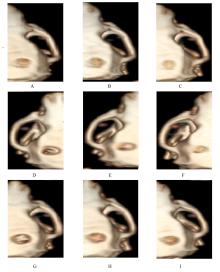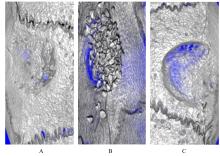| 1 |
白 彭, 叶 平, 吴润发. 引导骨再生技术中屏障膜的应用研究进展[J]. 中国口腔种植学杂志,2010, 15(3): 157-161.
|
| 2 |
徐丽娜, 王 琛. GBR技术与种植相关的研究进展[J]. 口腔医学, 2017, 37(9): 829-832.
|
| 3 |
WU L L, CHEUNG K Y, LAM P Y P, et al. Oral health indicators for risk of malnutrition in Elders[J]. J Nutr Health Aging, 2018, 22(2): 254-261.
|
| 4 |
白玉龙, 赵彦涛, 沈亚俊, 等. 3种植骨材料在大鼠下颌骨骨缺损修复实验中的长期效果观察[J]. 中国骨与关节损伤杂志, 2019, 34(6): 581-584.
|
| 5 |
何 帆, 熊秀利, 单显峰, 等. 引导骨再生研究中小型动物颅颌面临界骨缺损模型的应用[J]. 中国组织工程研究, 2021, 25(20): 3226-3231.
|
| 6 |
张 月, 王 瑾, 刘克达, 等. 纳米羟基磷灰石/胶原复合材料在口腔骨缺损中的应用及研究进展[J]. 中国实用口腔科杂志, 2020, 13(6): 375-378.
|
| 7 |
BOHNER M. Resorbable biomaterials as bone graft substitutes[J]. Mater Today, 2010, 13(1/2): 24-30.
|
| 8 |
YUAN Y, SHI X D, GAN Z H, et al. Modification of porous PLGA microspheres by poly-l-lysine for use as tissue engineering scaffolds[J]. Colloids Surf B Biointerfaces, 2018, 161: 162-168.
|
| 9 |
LI D W, SUN H Z, JIANG L M, et al. Enhanced biocompatibility of PLGA nanofibers with gelatin/nano-hydroxyapatite bone biomimetics incorporation[J]. ACS Appl Mater Interfaces, 2014, 6(12): 9402-9410.
|
| 10 |
GAO,TIANLIN,CUI,et al .Photo-immobilization of bone morphogenic protein 2 on PLGA/HA nanocomposites to enhance the osteogenesis of adipose-derivedste cells[J].RSC Advances,2016.
|
| 11 |
DEGIDI M, DAPRILE G, PIATTELLI A. Influence of stepped osteotomy on primary stability of implants inserted in low-density bone sites: an in vitro study[J]. Int J Oral Maxillofac Implants, 2017, 32(1): 37-41.
|
| 12 |
许长立, 封 伟. 骨密度与种植体初期稳定性关系研究[J]. 全科口腔医学电子杂志, 2019, 6(35): 26-27.
|
| 13 |
何 晶, 赵宝红. 骨密度影响种植体存留研究进展[J]. 中国实用口腔科杂志, 2014, 7(1): 53-58.
|
| 14 |
TAYLOR J C, CUFF S E, LEGER J P, et al. In vitro osteoclast resorption of bone substitute biomaterials used for implant site augmentation: a pilot study[J]. Int J Oral Maxillofac Implants, 2002, 17(3): 321-330.
|
| 15 |
VALENTINI P, ABENSUR D. Maxillary sinus floor elevation for implant placement with demineralized freeze-dried bone and bovine bone (Bio-Oss): a clinical study of 20 patients[J]. Int J Periodontics Restorative Dent, 1997, 17(3): 232-241.
|
| 16 |
GARCIA-JÚNIOR I R, SOUZA F Á, FIGUEIREDO A A S, et al. Maxillary alveolar ridge atrophy reconstructed with autogenous bone graft harvested from the proximal ulna[J]. J Craniofac Surg, 2018, 29(8): 2304-2306.
|
| 17 |
马士卿, 张 旭, 孙迎春, 等. 引导骨组织再生膜的研究进展[J]. 口腔医学研究, 2016, 32(3): 308-310.
|
| 18 |
YANG Y, ROSSI F M, PUTNINS E E. Periodontal regeneration using engineered bone marrow mesenchymal stromal cells[J].Biomaterials,2010,31(33): 8574-8582.
|
| 19 |
赵彬彬, 仲维剑, 马国武, 等. 三种不同骨移植材料成骨效果的比较[J]. 中国组织工程研究, 2021, 25(10): 1507-1511.
|
| 20 |
ZHANG H F, MAO X Y, DU Z J, et al. Three dimensional printed macroporous polylactic acid/hydroxyapatite composite scaffolds for promoting bone formation in a critical-size rat calvarial defect model[J]. Sci Technol Adv Mater, 2016, 17(1): 136-148.
|
| 21 |
孙 菲, 林婷婷, 袁晓烨, 等. nHA/BG涂层与Bio-Oss骨粉修复种植体骨缺损的实验研究[J]. 上海口腔医学, 2012, 21(4): 378-383.
|
| 22 |
FERREIRA N, SAINI A K, BIRKHOLTZ F F, et al. Management of segmental bone defects of the upper limb: a scoping review with data synthesis to inform decision making[J]. Eur J Orthop Surg Traumatol, 2021, 31(5): 911-922.
|
| 23 |
贾 琰,张保荣 .Regesi再生硅、Bio-Oss骨粉对成骨细胞增殖、成骨分化作用的影响[J].中国医药学报,2020,17(3):13-16.
|
| 24 |
魏安方, 王 娟, 魏取福, 等. 纳米羟基磷灰石/聚乳酸复合纳米纤维支架材料的研究[J]. 化工新型材料, 2018, 46(6): 78-81.
|
| 25 |
MA B, GAN J, ZHANG S,et al .Hydroxyapatite nanobelt/polylactic cacid Janus membrane with osteoinduction/barrier dual functionsfor precise bone defect Repair[J].Acta Biomater,2018,71:108-117.
|
| 26 |
毕 博, 臧圣奇, 何懋典, 等. 还原氧化石墨烯修饰壳聚糖骨组织工程支架的制备及表征[J]. 医学研究生学报, 2021, 34(4): 350-356.
|
| 27 |
施懿珈, 殷佳娣, 王天啸, 等. 纳米羟基磷灰石复合材料在口腔组织工程领域中的研究进展[J]. 徐州医科大学学报, 2021, 41(3): 231-234.
|
| 28 |
ZHAO J, HU J, WANG S, et al. Combination of β-TCP and BMP-2 gene-modified bMSCs to heal critical size mandibular defects in rats[J].Oral Dis,2010,16(1): 46-54.
|
| 29 |
XIA P F, ZHANG K X, FANG J J, et al. A novel fabrication of open porous poly-(γ-benzyl-l-glutamate) microcarriers with large pore size to promote cellular infiltration and proliferation[J]. Mater Lett, 2017, 206: 136-139.
|
| 30 |
ABUSHAHBA F, RENVERT S, POLYZOIS I, et al. Effect of grafting materials on osseointegration of dental implants surrounded by circumferential bone defects. An experimental study in the dog[J]. Clin Oral Implants Res, 2008, 19(4): 329-334.
|
 )
)




